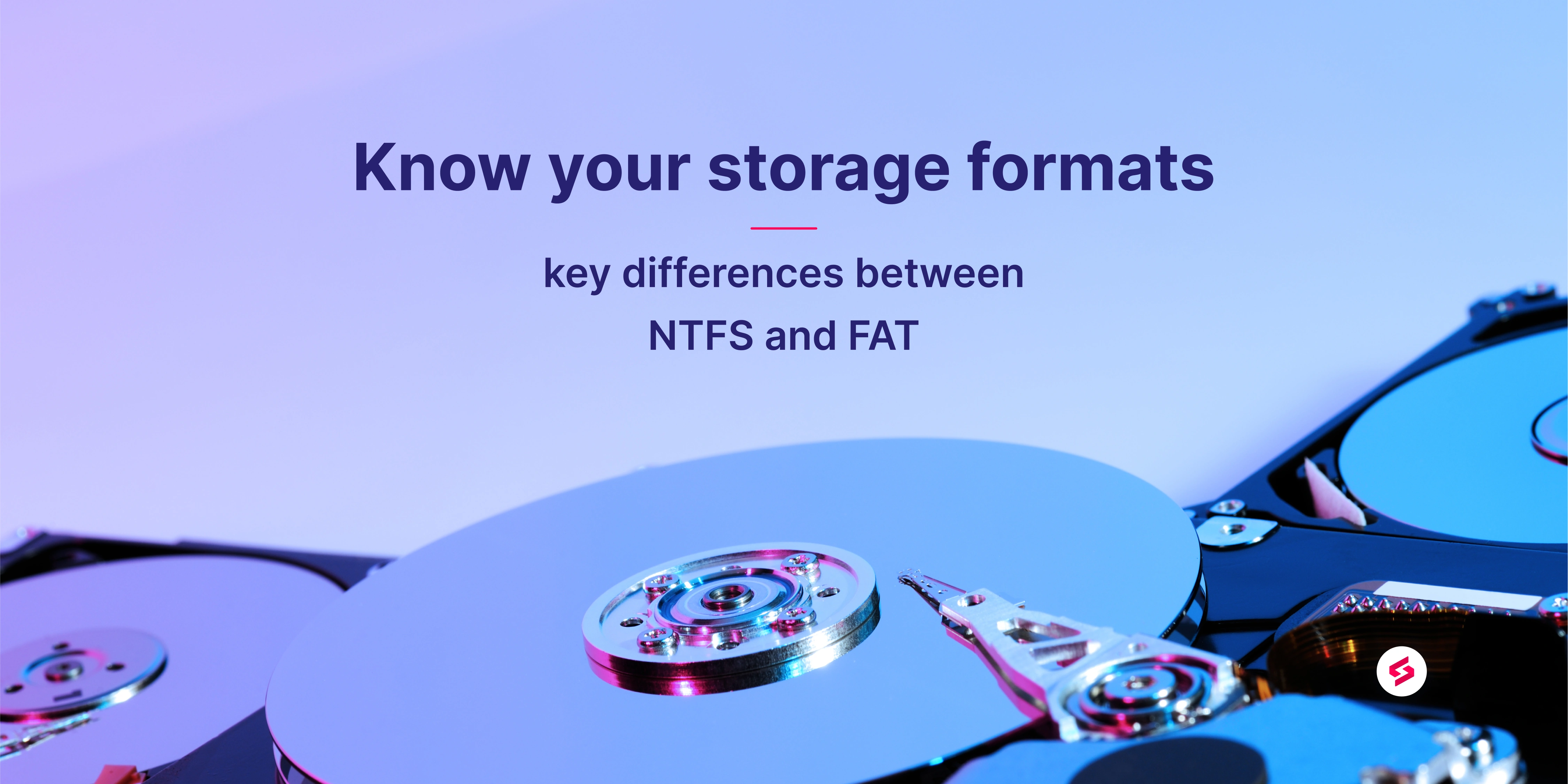As is well known nowadays, there is simply too much data in the world - and with it, the implied understanding that this data is stored on a system or a cloud.
There’s simply no escaping it, as our worlds expand we need to have more comprehensive insight into what is happening with our data. This also means doing a deep dive into what kind of file formats are being used when we store our data - at least this is something we have in our control when we look for physical backup options.
It’s a separate matter when it comes to cloud storage, and those who are not too picky may not be bothered by this situation at all. However, if you’re the type of person who likes to be particular about how their data is stored, you may want to read the rest of this blog, since we’ll be doing a deep dive into the key differences between NTFS and FAT file systems. Each has its own advantages and disadvantages, and can serve a particular set of requirements extremely well.
What do NTFS and FAT stand for?
FAT became one of the naming conventions for a filetype because it literally stands for file allocation table (FAT). It was originally designed for use with floppy disks, but was later adapted to be used on Windows devices as well, and has been in wide use since 1977! Now, NTFS is a much newer file system in comparison. It was introduced in 1993 and stands for New Technology File System. It was the system widely used in Windows NT 3.1. Right off the bat let’s mention that Mac systems can only read NTFS files and not write over them - which is a bit of a drawback of using NTFS. However, that’s just the tip of the iceberg. Let’s take a closer look at both these file systems and see which ones are better suited to the needs of a modern user, with the nitty-gritties of modern day contexts, beginning with the file system that came earlier - FAT.
FAT - File Allocation Table
FAT is actually the simplest system on offer for file storage, and that’s perhaps one of the reasons why it finds such widespread use. This is especially true of the Apple ecosystem. The table (which is referred to in the name) resides on the top layer of the volume of data, and there is a copy of the table kept just in case one of the tables gets corrupted, so that there is always a secure layer of data.
When we have a disk formatted with FAT, there is a cluster-based storage system in play. The size of the volume determines the size of the cluster of data that gets allocated. The FAT table gets updated with an entry once a file gets created. At that point, a cluster number containing the data is also generated. The FAT table entry either denotes that it is the last entry in the cluster or points to another entry volume.
When it comes to organization for storing data, there is none. All files are assigned the first location that is open for them. In addition to this, an important part of the storage process in FAT file systems is the regular updation of the FAT table, without which there is a strong possibility of data loss. For another interesting data point, all filenames of FAT systems need to follow the ASCII code and the 8.3 file naming convention also needs to be strictly adhered to.
NTFS - New Technology File System
As a file storage technology, NTFS continues to build on a file system that was released before - called HPFS (High Performance File System). With HPFS - and by that token, NTFS as well - there is a greater emphasis on being able to do more with the files as they are stored. For example, files can automatically get sorted into specific directories based on their file names, and the character lengths of the files themselves was also upgraded to fit up to 254 characters.
NTFS, continuing over the tradition from HPFS, also includes more information per unit volume than FAT. It includes data regarding access (both date and time), as well as the creation and modification of the volume itself. Instead of using the cluster pointing method that was present in FAT, here, the data entries point to an FNODE structure, which contains the actual data itself, or in turn points to other structures that may contain or (in turn) point to other structures that house the data. There is also an attempt to store as much data in a contiguous manner as possible, which results in some advantages like lower disk space use, as well as faster processing of files.
In addition to this, it does improve upon some of the features that are found in HPFS as well. For example, there is no requirement of any physical hardware (such as 512-byte sectors). In fact, it does away with the “special” objects on the disk, as well as no special location - such as the allocation table in FAT systems, for example. The naming convention of NTFS is about the same as FAT, only that it preserves case, while not being case-sensitive.
In addition to this, it has some specific features that are unique to it. These include:
Increased functionality: One of the key design principles behind NTFS was to allow users to build upon it in ways that feel functional yet facilitate ease of use. Thus, one of the main features of NTFS is that a user can modify the attributes of any data they store, thereby giving them more control over the data.
Fewer limitations: Another limitation that NTFS categorically removed was that of file size. Here, each file can have a maximum size of up to 18,446,744,073,709,551,616 bytes - or 16 exabytes. In addition, all filenames followed the same naming conventions as in FAT and HFPS, with Unicode names also being stored as they were. Further, the possibility of encountering different disk system technology at some point is also accounted for - so you can rest assured that your data will survive all changes!
More reliable: The NTFS file system address two crucial points of changes from FAT and HPFS. The first is data recoverability - NTFS allows for data to be brought back on the system by quickly running a CHKDSK, whose goal will be to verify all the transactions committed in the system. Once that step is done, it only needs to revert to an earlier checkpoint, and your data will come right back. In addition, NTFS avoids single sector failures by never using special objects in the first place (since the definition of a single sector failure is the corruption of the special object). Further, it also stores multiple copies of all files - as the Master File Table.
POSIX support: NTFS is the only file system that has active support for POSIX.1, and supports time stamping (thereby providing more data around a file’s usage), hard links (wherein two separate file locations point to the same data), as well as case-sensitive naming (so hello.txt and HELLO.txt will be different files).
Advantages and Disadvantages of FAT
One of the most impressive advantages of the FAT file system is that if you load it on MS-DOS, then you can undelete that file. Also, it works best for files under 200 MB, since in that scenario it can function very well with very little overhead. The disadvantages of working with FAT are rather heavy and can slow down workloads if not implemented in the right way within the right context. The further a file size goes north of 200 MB, the more exponentially the performance of the file system reduces. There is a maximum capacity of 4 GB on Windows NT and 2 GB on MS-DOS for FAT partitions.
Advantages and Disadvantages of NTFS
NTFS is the best best for you if your files are north of 400 MB in size, because here performance does not reduce at an exponential rate. In fact, it doesn’t reduce at all! Moreover, the baked-in recoverability features ensure that an average user does not have to struggle with recovering their data - they should be able to manage this through simple user-friendly operations.
However, there are some scenarios in which it may be advisable for you not to be using NTFS at all. The first such scenario is if your file sizes are less than 400 MB - because NTFS requires a significant buffer to operate vis-a-vis memory, and the 4 MB overhead (which it uses typically over a standard 100 MB disk) may be too much for certain users to give up. In addition to this, there is no encryption on NTFS disks - this means anybody can theoretically load up NTFS disks on MS-DOS and view all the data inside. This, expectedly, can be a deal-breaker for some people.
Conclusion
As data demands increase across the world, and the demand for personalized data devices also increases, it’s only a matter of time before consumers will want to access information about the type of system their devices are using to store their precious data. By being fully aware of all the different types of file systems available, you can make a more informed decision into how you wish to store your data - and also be prepared for the eventual possibility that new forms of data storage can be introduced, to which you will have to adapt (as well as adopt) on a fairly short timeline.




